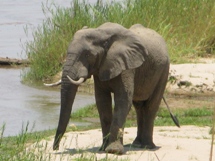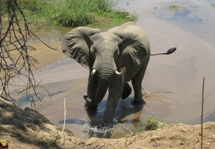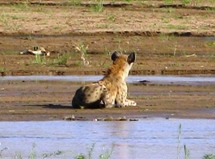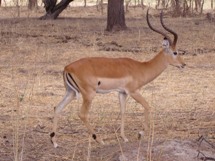Zambia (1): Day Fifteen : Buffalo Camp
Following an early morning walk we returned to camp, to be visited by Charlie the elephant just before brunch, and who stood grazing a short distance away in the river bed (![]() ). I then tried to get as close as possible by going on my own along the bank to a spot immediately above him, some distance from the camp.
). I then tried to get as close as possible by going on my own along the bank to a spot immediately above him, some distance from the camp.
After I’d obtained a number of excellent shots of him splashing about down below, Charlie suddenly got fed up with being a photo star and (mock?) charged me (![]() ). He was actually situated at the base of a high near-vertical bank, and (probably) therefore couldn’t actually have reached me. In any event the golden rule is never to run in such circumstances, since it only encourages pursuit. However I actually ran like hell! Charlie actually came into camp (looking for me?) during the afternoon, and had to be chased off.
). He was actually situated at the base of a high near-vertical bank, and (probably) therefore couldn’t actually have reached me. In any event the golden rule is never to run in such circumstances, since it only encourages pursuit. However I actually ran like hell! Charlie actually came into camp (looking for me?) during the afternoon, and had to be chased off.
After tea at 3.30 the vehicle took us about 200 metres upriver where we stopped to watch a hyena in the river bed (![]() ) Then we saw two lionesses on the opposite bank almost hidden in the grass. A family of warthogs (
) Then we saw two lionesses on the opposite bank almost hidden in the grass. A family of warthogs (![]() ) approached the river to drink unaware of the presence of the lionesses who immediately gave chase. The warthogs all disappeared in different directions into the distance and we hoped that they got away safely. The vehicle then dropped us off for a further two hour walk, during which we saw a civet approaching, and we stayed very still. It didn’t seem to see us and walked towards us and then past us very close by. The vehicle then met up with us again and we enjoyed several sundowners before going on a night drive.
) approached the river to drink unaware of the presence of the lionesses who immediately gave chase. The warthogs all disappeared in different directions into the distance and we hoped that they got away safely. The vehicle then dropped us off for a further two hour walk, during which we saw a civet approaching, and we stayed very still. It didn’t seem to see us and walked towards us and then past us very close by. The vehicle then met up with us again and we enjoyed several sundowners before going on a night drive.
![]()
As an indication of the depth of understanding that you can aspire to in the area of tracking and so on, consider the photograph below (![]() ). I came across these droppings whilst out on a walking safari with a number of guests, and was able to amaze them by not only identifying the species of the animal responsible, but also its sex, its probable location at that moment, and its name.
). I came across these droppings whilst out on a walking safari with a number of guests, and was able to amaze them by not only identifying the species of the animal responsible, but also its sex, its probable location at that moment, and its name.
Species? The answer is an impala (![]() ) – fairly easy to identify, although a number of antelope leave very similar droppings, such as puku, waterbuck and bushbuck. In particular it is quite difficult to distinguish an isolated impala dropping from that of a puku; however they can be distinguished by consideration of the habitat in which they are found, and by comparison with other droppings nearby (impala tend to revisit the same point to defecate, leading to large ‘middens’, while puku defecate at random).
) – fairly easy to identify, although a number of antelope leave very similar droppings, such as puku, waterbuck and bushbuck. In particular it is quite difficult to distinguish an isolated impala dropping from that of a puku; however they can be distinguished by consideration of the habitat in which they are found, and by comparison with other droppings nearby (impala tend to revisit the same point to defecate, leading to large ‘middens’, while puku defecate at random).
Sex? The answer is male. You can see that the animal urinated at the same time as defecating. However although in the case of a female, the droppings would be centred on the circle of urine, in the case of a male, for obvious anatomical reasons, the circle of urine is displaced from the centre of the pile of droppings. Location? To the right of the pile of droppings, as shown here. This male impala was obviously facing to the right at the time, and since the droppings are very recent (the urine hasn’t dried out fully yet) it is very likely that it moved ahead in that same direction, and is still over there.
Name? Albert – but I’m not going to give away all my tracking secrets by telling you how I knew this!
| Back to previous page (Day 14) | Forward to next page (Day 16) |




![]()
